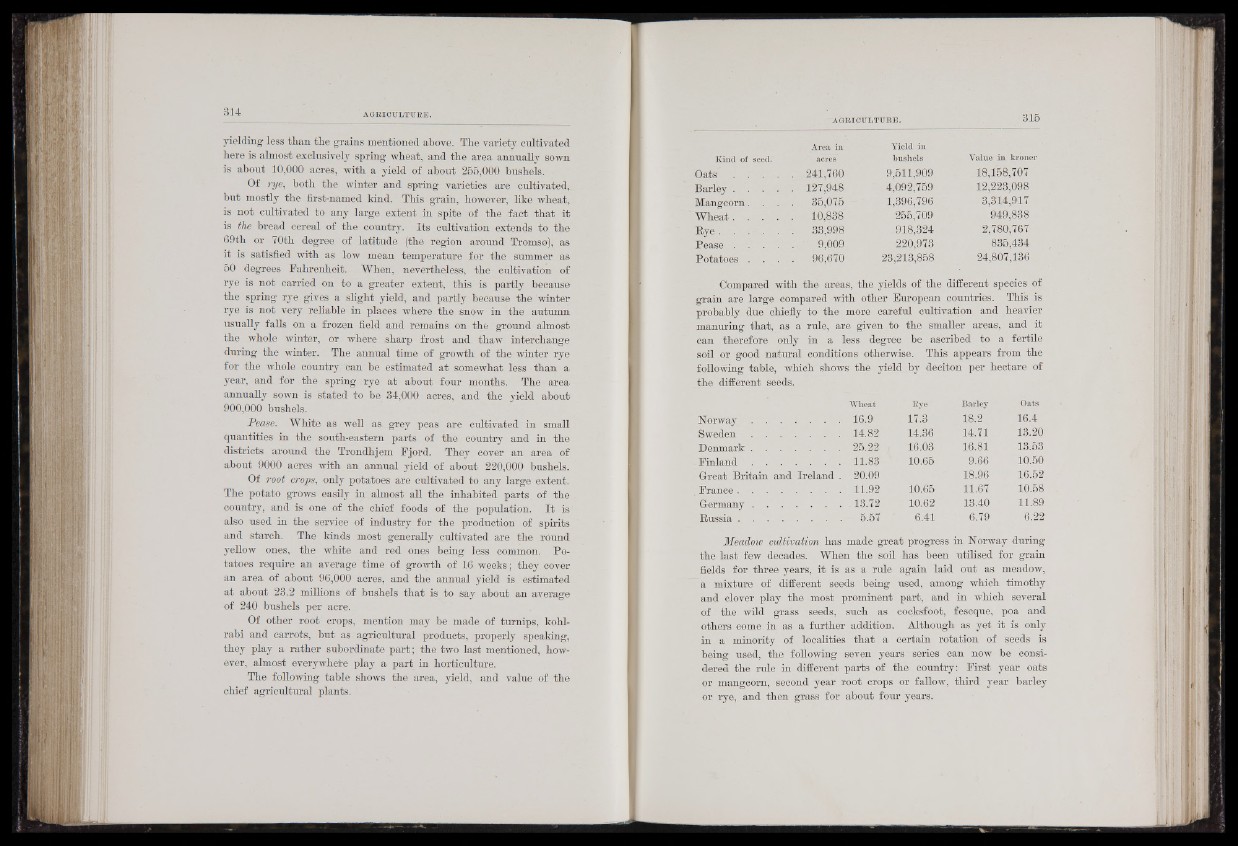
yielding less than the grains mentioned above. The variety cultivated
here is almost exclusively spring wheat, and the area annually sown
is about 10,000 acres, with a yield of about 255,000 bushels.
Of rye, both the winter and spring varieties are cultivated,
but mostly the first-named kind. This grain, however, like wheat,
is not cultivated to any large extent in spite of the fact that it
is the bread cereal of the country. Its cultivation extends to the
69th or 70th degree of latitude (the region around Tromso), as
it is satisfied with as low mean temperature for the summer as
50 degrees Fahrenheit. When, nevertheless, the cultivation of
rye is not carried on to a greater extent, this is partly because
the spring rye gives a slight yield, and partly because the winter
rye is not very reliable in places where the snow in the autumn
usually falls on a frozen field and remains on the ground almost
the whole winter, or where sharp frost and thaw interchange
during the winter. The annual time of growth of the winter rye
for the whole country can be estimated at somewhat less than a
year, and for the spring rye at about four months. The area
annually sown is stated to be 34,000 acres, and the yield about
900,000 bushels.
Pease. White as well as grey peas are cultivated in small
quantities in the south-eastern parts of the country and in the
districts around the Trondhjem Fjord. They cover an area of
about 9000 acres with an annual yield of about 220,000 bushels.
Of root crops, only potatoes are cultivated to any large extent.
The potato grows easily in almost all the inhabited parts of the
country, and is one of the chief foods of the population. I t is
also used in the service of industry for the production of spirits
and starch. The kinds most generally cultivated are the round
yellow ones, the white and red ones being less common. Potatoes
require an average time of growth of 16 weeks; they cover
an area of about 96,000 acres, and the annual yield is estimated
at about 23.2 millions of bushels that is to say about an average
of 240 bushels per acre.
Of other root crops, mention may be made of turnips, kohlrabi
and carrots, but as agricultural products, properly speaking,
they play a rather subordinate part; the two last mentioned, however,
almost everywhele play a part in horticulture.
The following table shows the area, yield, and value of the
chief agricultural plants.
Area in Yield in
Kind of seed. acres bushels Value in kroner
Oats . . . . 241,760 9,511,909 18,158,707
Barley . . . . . 127,948 4,092,759 12,223,098
Mangcorn. 35,075 1,396,796 3,314,917
Wheat . . . . . 10,838 255,709 949,838
Eye. . . . . . 33,998 918,324 2,780,767
Pease . . . . .. ' 9,009 220,973 835,434
Potatoes . . . 96,670 23;213,858 : 24,807,136
Compared with the areas, the yields of the different species of
grain are large compared with other European countries. This is
probably due chiefly to the more careful cultivation and heavier
manuring that, as a rule, are given to the smaller areas, and it
can therefore only in a less degree be ascribed to a fertile
soil or good natural conditions otherwise. This appears from the
following table, which shows the yield by deciton per hectare of
the different seeds.
Wheat Eye Barley Oats
N o rw a y .............................. 16,9 17.3 18,2 16.4
S w e d e n .............................. 14.82 14.36 14.71 13.20
Denmark.............................. 25.22 r 16.03 16.81 13.53
F i n l a n d .............................. 11 83 10.65 9.66 10.50
Great Britain and Ireland . 20.09 18.96 16.52
France . ............................... 11 92 10.65 11.67 10.58
Germany . . . . . 13.72 10.62 13.40 11.89
Eussia .................................... 5.57 6.41 6.79 6.22
Meadow cultivation has made great progress in Norway during
the last few decades. When the soil has been utilised for grain
fields for three years, it is as a rule again laid out as meadow,
a mixture of different seeds being used, among which timothy
and clover play the most prominent part, and in which several
of the wild grass seeds, such as cocksfoot, fescque, poa and
others come in as a further addition. Although as yet it is only
in a minority of localities that a certain rotation of seeds is
being used, the following seven years series can now be considered
the rule in different parts of .the country: First year oats
or mangcorn, second year root crops or fallow, third year barley
or rye, and then grass for about four years.